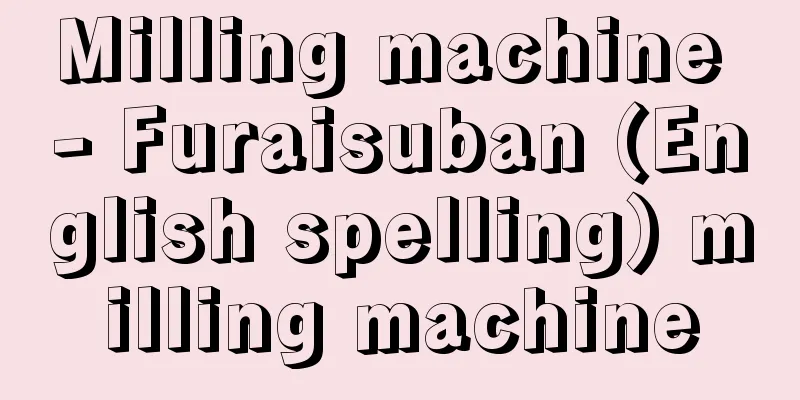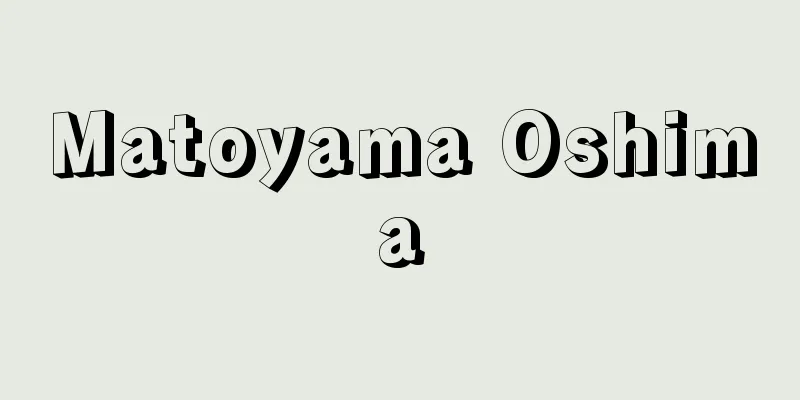Milling machine - Furaisuban (English spelling) milling machine

|
A milling cutter is a machine tool that performs machining using a tool with one or many cutting edges. The word milling is said to come from the German word "Fräse" and the French and Dutch words "Fraise" (fur collar). The milling machine was invented in 1800 by American E. Whitney for machining interchangeable firearms. A milling machine is a machine that imparts rotational motion to the tool and three-dimensional relative motion between the tool and the workpiece. Depending on how this relative motion is imparted and the type of tool used, it can cut a wide range of shapes, including flat surfaces, curved surfaces, grooves (straight grooves, helical grooves), cams, and gears. Therefore, the milling machine has a wide range of applications and is highly versatile, making it one of the most widely used machine tools today, along with lathes and drill presses. Milling machines are divided into many types based on their size and processing capacity, but they are also divided into knee-type and bed-type based on the difference in structure for providing vertical relative motion between the tool and the workpiece. The knee-type moves the workpiece side up and down, while the bed-type moves the machining tool side up and down. Knee milling machines are divided into vertical milling machines, where the spindle is vertical, and horizontal milling machines, where the spindle is horizontal, and among horizontal milling machines, those with a rotating table or spindle head are called universal milling machines. There are also ram milling machines, where the spindle head is attached to a ram on a column and the ram moves back and forth, and among these, there are those where the spindle head can tilt left and right, and those where the ram rotates within a plane. Like the knee type, bed type milling machines are also available in vertical and horizontal types depending on the direction of the main spindle. Among the bed type, those that are suitable for mass production, with the up and down movement of the main spindle and the back and forth movement of the workpiece semi-fixed and mainly focused on the left and right movement of the table, are called production milling machines. A knee milling machine consists of the basic structural elements of a column, knee, saddle, and table; the knee with the table and saddle on it moves up and down, the saddle on the knee moves back and forth, and the table on the saddle moves left and right, allowing for three-dimensional movement of the workpiece. The main spindle is built into the column. The greatest feature of this milling machine is its ease of operation, and it can be fitted with various accessories to perform a wide range of machining, making it the most widely used milling machine. It is generally intended for machining small parts, with medium or less production volume, and is suitable for cases with complex cutting surfaces or many cutting surfaces. Bed-type milling machines eliminate the up and down movement of the knee in knee-type milling machines, instead using the spindle head to perform the up and down movement, and the table reciprocates on a bed fixed to the floor. Therefore, it is not affected by the weight of the workpiece, making it suitable for machining heavy objects, and its accuracy is stable. In addition to the above, there are also special milling machines such as the planomiller, a large milling machine equipped with a spindle head instead of the bit of a planing machine, as well as screw milling machines, tool milling machines, die-sinking milling machines, and rotary table milling machines. In the case of milling machines, the working space in particular is an important factor in indicating the size of the machine, and it is generally expressed using numbers such as number two, number three, number four, etc. [Shimizu Shinji] [Reference item] | | |©Shogakukan "> Structure of a milling machine (vertical milling machine/hi… ©Shogakukan "> Milling machine operation example Source: Shogakukan Encyclopedia Nipponica About Encyclopedia Nipponica Information | Legend |
|
フライスとよばれる一枚ないし多数枚の切刃をもつ工具を用いて加工を行う工作機械。フライスとは、ドイツ語の「Fräse」や、フランス語およびオランダ語の「Fraise」(襞襟(ひだえり))に由来するといわれている。1800年アメリカのE・ホイットニーが互換性のある銃器の工作用として発明したのがフライス盤の始まりといわれている。フライス盤は、工具に回転運動、また工具と工作物の間に三次元相対運動を与える機械であるが、この相対運動の与え方と用いる工具の種類によって、平面、曲面、溝(直溝、ねじれ溝)、カム、歯車などの広範な形状を切削することができる。したがって、フライス盤の作業範囲は広く汎用(はんよう)性に富むため、旋盤、ボール盤とともに現在もっとも広く使用されている工作機械の一つである。 フライス盤は、その大きさ、加工能力により多くの種類に分けられるが、とくに工具と工作物に上下相対運動を与えるための構造上の違いによって、ひざ形とベッド形に区分されている。工作物側を上下させるのがひざ形で、加工工具側を上下させるのがベッド形である。 ひざ形フライス盤は、主軸の方向が垂直な立て形フライス盤と、水平の横形フライス盤とに分かれ、さらに横形フライス盤のなかで、テーブルや主軸頭などが旋回するものを万能フライス盤という。また、ラム形フライス盤といって、コラム上のラムに主軸頭がつき、そのラムが前後に出入りするものもあり、このなかには、主軸頭が左右に傾斜できるもの、ラムが平面内で旋回するものなどがある。 ベッド形フライス盤についても、ひざ形と同様に、主軸の方向により立て形と横形がある。ベッド形のなかで、主軸の上下運動および加工物の前後運動を半固定にし、テーブルの左右運動を主体にした大量生産に適したものを生産フライス盤という。 ひざ形フライス盤は、コラムcolumn、ニーknee、サドルsaddle、テーブルtableの基本構造要素からなり、テーブルとサドルをのせたニーが上下に動き、ニー上のサドルは前後方向に動き、サドル上のテーブルは左右に動き、工作物の三次元運動を可能にしている。主軸はコラムの中に組み込まれている。このフライス盤の最大の特徴は操作性のよいことで、各種の付属装置を取り付けて広範囲の加工を行うことができ、もっとも多く使用されているフライス盤である。一般には小物部品の加工を対象とし、製作個数は中量生産以下で、複雑な切削面や多くの切削面を有する場合に適している。 ベッド形フライス盤は、ひざ形におけるニーの上下運動をなくし、主軸頭によって上下運動を行わせ、テーブルは床上に固定されたベッド上を往復運動する構造である。したがって加工物の重さに影響されず、重量物の加工に適し、精度も安定している。 以上のほかに特殊なフライス盤として、平削り盤のバイトのかわりに主軸頭を装備したフライス切削用大型機械のプラノミラーや、ねじフライス盤、工具フライス盤、形彫りフライス盤、ロータリーテーブル形フライス盤などがある。 フライス盤の場合、とくに作業空間が機械の大きさを表す重要なポイントで、一般に、二番、三番、四番などと、番手を用いて表している。 [清水伸二] [参照項目] | | |©Shogakukan"> フライス盤の構造(立て形フライス盤/ひ… ©Shogakukan"> フライス盤の作業例 出典 小学館 日本大百科全書(ニッポニカ)日本大百科全書(ニッポニカ)について 情報 | 凡例 |
>>: Bryce Canyon National Park - Bryce Canyon National Park
Recommend
The five great powers of love - Godairikikoi no fujime
Kabuki script. Domestic drama. Three acts. Writte...
American Board of Commissioners for Foreign Missions
The oldest interdenominational foreign mission org...
Efferent fibers
...For example, cats have 13 pairs of thoracic ne...
Euphorbia pseudochamaesyce (English spelling)
… [Morita Tatsuyoshi]. … *Some of the terminology...
Upside-down frogs - upside-down frogs
…The larvae usually metamorphose within 2–3 month...
One gene, one polypeptide theory
... Thus, it was thought that genes directly cont...
Huahine
…The islands are further divided into two groups:...
Dialkyl peroxide - Dialkyl peroxide
...Many metal peroxoacid salts, such as peroxochr...
Noburo Ohfuji
1900-1961 An animation creator from the Taisho an...
Flatfish casting net - Flatfish casting net
…It is unclear when hand-held nets were developed...
Oorusui - Oorusui
...a person who manages a castle in place of the ...
Angular distance - Kakukyori
The distance between two points expressed in degr...
Nísos Kérkyra (English spelling)
...area: 593 km2 , population: 97,000 (1981). The...
Torazaburo Araki
A medical scientist from Gunma Prefecture. He gra...
Inagaki Taruho - Inagaki Taruho
Novelist. Born in Osaka. Interested in airplanes,...









